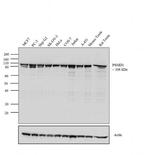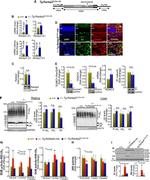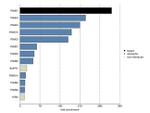Search Thermo Fisher Scientific
FIGURE: 1 / 3
PSMD1 Antibody (PA1-973) in WB



Product Details
PA1-973
Species Reactivity
Published species
Host/Isotype
Class
Type
Immunogen
Conjugate
Form
Concentration
Purification
Storage buffer
Contains
Storage conditions
Shipping conditions
RRID
Product Specific Information
PA1-973 detects proteasome 19S subunit S1 from from human cells.
PA1-973 has been successfully used in Western blot and immunohistochemistry procedures. By Western blot, this antibody detects an ~105 kDa protein representing proteasome 19S subunit S1 from HeLa cell extract.
PA1-973 immunizing peptide corresponds to amino acid residues 929-953 from human proteasome 19S subunit S1 protein.
Target Information
Proteolytic degradation is critical to the maintenance of appropriate levels of short-lived and regulatory proteins as important and diverse as those involved in cellular metabolism, heat shock and stress response, antigen presentation, modulation of cell surface receptors and ion channels, cell cycle regulation, transcription, and signalling factors. The ubiquitin-proteasome pathway deconstructs most proteins in the eukaryotic cell cytosol and nucleus. Others are degraded via the vacuolar pathway which includes endosomes, lysosomes, and the endoplasmic reticulum. The 26S proteasome is an ATP-dependent, multisubunit (~31), barrel-shaped molecular machine with an apparent molecular weight of ~2.5 MDa. It consists of a 20S proteolytic core complex which is crowned at one or both ends by 19S regulatory subunit complexes. The 19S regulatory subunits recognize ubiquitinated proteins and play an essential role in unfolding and translocating targets into the lumen of the 20S subunit. An enzymatic cascade is responsible for the attachment of multiple ubiquitin molecules to lysine residues of proteins targeted for degradation. Several genetic diseases are associated with defects in the ubiquitin-proteasome pathway. Some examples of affected proteins include those linked to cystic fibrosis, Angelman’s syndrome, and Liddle syndrome.
For Research Use Only. Not for use in diagnostic procedures. Not for resale without express authorization.
Bioinformatics
Protein Aliases: 26S proteasome non-ATPase regulatory subunit 1; 26S proteasome p112 subunit; 26S proteasome regulatory subunit RPN2; 26S proteasome regulatory subunit S1; 26S proteasome subunit p112; 26S proteasome, subunit p112; MGC133040; MGC133041; proteasome (prosome, macropain) 26S subunit, non-ATPase, 1; proteasome 26S non-ATPase subunit 1
Gene Aliases: 2410026J11Rik; P112; PSMD1; Rpn2; S1
UniProt ID: (Human) Q99460, (Mouse) Q3TXS7, (Rat) O88761
Entrez Gene ID: (Human) 5707, (Bovine) 511803, (Mouse) 70247, (Rat) 83806

Performance Guarantee
If an Invitrogen™ antibody doesn't perform as described on our website or datasheet,we'll replace the product at no cost to you, or provide you with a credit for a future purchase.*
Learn more
We're here to help
Get expert recommendations for common problems or connect directly with an on staff expert for technical assistance related to applications, equipment and general product use.
Contact tech support
